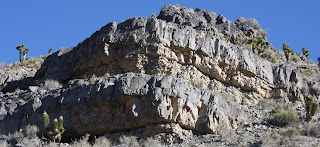Anyway, we flew into the festering pit of decadence and hubris that is Las Vegas, and immediately made our way for the Spring Mountains, where we set up camp just below the snow line. Come dawn, we found that we’d pitched our tents next to some pretty neat outcrops, so our first stop was an hour of poking around some pretty nifty carbonate parasequences, shown in the picture below.

This picture was actually taken by a friend of mine, with a camera that I understand cost approximately $6,000,000,000, and therefore, takes very large and very good pictures. Anyway, you can see two “cycles” capped by thick, dark grey limestones. The lower portion of a cycle is made up of thinnly bedded carbonate with some disseminated sponge spicules and rare floating quartz grains, whereas the upper capping unit is made up of thick carbonate mud and silicified stromatoporoids, which were a spongey sort of reef builder in the Devonian. They’re shown in the picture below, again courtesy of my friend with the golden camera (I was selfishly saving my limited memory card for some alluvial fan stuff).

At the VERY top of the “cycle” picture above, we found a calci-clastic unit that exhibited some pretty nice (you know, for limestone) hummocky- and swaley-cross stratification. I think the picture below was mine, actually.

So the cycles seemed to be showing a lower, thinnly bedded limestone that was separated from overlying reef deposits by a sharp surface, which was itself sharply overlain by storm influenced reworked carbonates. Maybe this represents a shallowing upwards carbonate parasequence? Alternatively, I guess it could also maybe show a back-reef, reef, fore-reef trend? This is why I like siliciclastics; they do what the hydrodyanamics tells them to do.
Anyway, I think I’ve used up my allotted digital volume of images as dictated by Blogger, so I’ll have to post the rest of Day One later.




No comments:
Post a Comment